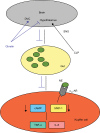Mechanism of the inhibitory effect of ghrelin in sepsis
- PMID: 24367207
- PMCID: PMC3846870
- DOI: 10.2147/hmer.s7187
Mechanism of the inhibitory effect of ghrelin in sepsis
Abstract
Sepsis and septic shock are the leading causes of death in intensive care units. Approximately 40%-70% of the mortality is associated with severe sepsis and septic shock. Systemic antibiotic usage, surgical intervention, aggressive fluid resuscitation and careful monitoring are common measures currently used to treat sepsis. Despite the advances in the understanding of the pathophysiology of sepsis, very little progress has been made towards therapeutic interventions. Recently we have shown that ghrelin, a stomach-derived peptide which is an endogenous ligand for the growth hormone secretagogue receptor (GHSR-1a), is beneficial in attenuating the inflammatory response, organ injury and mortality in an experimental model of polymicrobial sepsis induced by cecal ligation and puncture (CLP). In this review, we describe the mechanism of action of ghrelin in sepsis, highlight the role ghrelin plays in attenuating the hepatic dysfunction induced by sepsis and septic shock and suggest in developing ghrelin as a potential therapy for sepsis.
Keywords: GHSR-1a; cecal ligation; ghrelin; inhibition septic shock; sepsis.
Figures

Similar articles
-
Upregulation of cardiovascular ghrelin receptor occurs in the hyperdynamic phase of sepsis.Am J Physiol Heart Circ Physiol. 2004 Sep;287(3):H1296-302. doi: 10.1152/ajpheart.00852.2003. Epub 2004 May 20. Am J Physiol Heart Circ Physiol. 2004. PMID: 15155262
-
Ghrelin inhibits sympathetic nervous activity in sepsis.Am J Physiol Endocrinol Metab. 2007 Dec;293(6):E1697-702. doi: 10.1152/ajpendo.00098.2007. Epub 2007 Oct 2. Am J Physiol Endocrinol Metab. 2007. PMID: 17911350
-
Ghrelin/GHSR Axis Induced M2 Macrophage and Alleviated Intestinal Barrier Dysfunction in a Sepsis Rat Model by Inactivating E2F1/NF-κB Signaling.Can J Gastroenterol Hepatol. 2023 Dec 29;2023:1629777. doi: 10.1155/2023/1629777. eCollection 2023. Can J Gastroenterol Hepatol. 2023. PMID: 38187112 Free PMC article.
-
Surviving sepsis campaign: international guidelines for management of severe sepsis and septic shock: 2012.Crit Care Med. 2013 Feb;41(2):580-637. doi: 10.1097/CCM.0b013e31827e83af. Crit Care Med. 2013. PMID: 23353941
-
Experimental Protocol for Cecal Ligation and Puncture Model of Polymicrobial Sepsis and Assessment of Vascular Functions in Mice.Methods Mol Biol. 2018;1717:161-187. doi: 10.1007/978-1-4939-7526-6_14. Methods Mol Biol. 2018. PMID: 29468592 Review.
Cited by
-
Ghrelin Alleviates Intestinal Dysfunction in Sepsis Through the KLF4/MMP2 Regulatory Axis by Activating SIRT1.Front Immunol. 2021 Apr 23;12:646775. doi: 10.3389/fimmu.2021.646775. eCollection 2021. Front Immunol. 2021. Retraction in: Front Immunol. 2024 May 17;15:1430764. doi: 10.3389/fimmu.2024.1430764. PMID: 33968038 Free PMC article. Retracted.
-
Ghrelin regulates sepsis‑induced rat acute gastric injury.Mol Med Rep. 2019 Jun;19(6):5424-5432. doi: 10.3892/mmr.2019.10208. Epub 2019 Apr 30. Mol Med Rep. 2019. PMID: 31059095 Free PMC article.
-
Ghrelin as an Anti-Sepsis Peptide: Review.Front Immunol. 2021 Jan 28;11:610363. doi: 10.3389/fimmu.2020.610363. eCollection 2020. Front Immunol. 2021. PMID: 33584688 Free PMC article. Review.
-
Electroacupuncture improves acute bowel injury recovery in rat models.Exp Ther Med. 2017 Nov;14(5):4655-4662. doi: 10.3892/etm.2017.5159. Epub 2017 Sep 21. Exp Ther Med. 2017. PMID: 29201164 Free PMC article.
-
Sepsis as a Pan-Endocrine Illness-Endocrine Disorders in Septic Patients.J Clin Med. 2021 May 12;10(10):2075. doi: 10.3390/jcm10102075. J Clin Med. 2021. PMID: 34066289 Free PMC article. Review.
References
-
- Angus DC, Linde-Zwirble WT, Lidicker J, Clermont G, Carcillo J, Pinsky MR. Epidemiology of severe sepsis in the United States: analysis of incidence, outcome, and associated costs of care. Crit Care Med. 2001;29(7):1303–1310. - PubMed
-
- Annane D, Aegerter P, Jars-Guincestre MC, Guidet B. Current epidemiology of septic shock: the CUB-Rea Network. Am J Respir Crit Care Med. 2003;168(2):165–172. - PubMed
-
- Wang P, Chaudry IH. Mechanism of hepatocellular dysfunction during hyperdynamic sepsis. Am J Physiol. 1996;270(5 Pt 2):R927–R938. - PubMed
-
- Wang P, Ba ZF, Chaudry IH. Hepatic extraction of indocyanine green is depressed early in sepsis despite increased hepatic blood flow and cardiac output. Arch Surg. 1991;126(2):219–224. - PubMed
-
- Wang P, Ba ZF, Chaudry IH. Hepatocellular dysfunction occurs earlier than the onset of hyperdynamic circulation during sepsis. Shock. 1995;3(1):21–26. - PubMed
Publication types
Grants and funding
LinkOut - more resources
Full Text Sources
Miscellaneous

